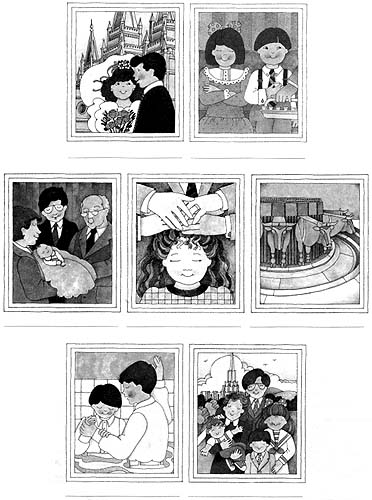“Sharing Time: Temples and Ordinances,” Tambuli, Mar. 1993, 6
Sharing Time:
Temples and Ordinances
“Let this house be built unto my name, that I may reveal mine ordinances therein unto my people” (D&C 124:40).
The word ordinance has special meaning in the Church. An ordinance is a sacred ceremony. When we participate in an ordinance, we make covenants or promises to obey Heavenly Father’s commandments.
Instructions
Look at the pictures and identify the ordinances. Write the name of the ordinance beneath the picture, using the list below. Then read the descriptions of some of the ordinances we have in the Church and color the frames of the pictures as indicated. Some frames may be more than one color.
Sacrament
Baptism
Blessing a baby
Celestial marriage
Laying on of hands for the gift of the Holy Ghost
Baptism for the dead
Sealing

Illustrated by Julie Young
-
Some ordinances are called saving ordinances. These ordinances are necessary for salvation. Jesus described two saving ordinances when he said, “Except a man be born of water and of the Spirit, he cannot enter into the kingdom of God” (John 3:5). Being born of water means being baptized, and being born of the Spirit means the laying on of hands for the gift of the Holy Ghost. Other saving ordinances are sealings and celestial marriage. (See D&C 131:1–2.)
Color the frames around the saving ordinances red.
-
Some ordinances are performed only in holy temples. Some of these ordinances include baptism for the dead, celestial marriage, and sealings.
Color the frames around the temple ordinances blue.
-
Many other ordinances are also performed in the Church, such as partaking of the sacrament, and the blessing of babies.
Color the remaining frames yellow.
We are blessed to live in a time when we have holy temples upon the earth and can receive temple ordinances. Without temples, those ordinances would not be available for us or for our loved ones who have died. Because of temples, all people who have ever lived can have saving ordinances performed in their behalf.
Sharing Time Ideas
-
Invite children to tell where they were baptized. Explain that children living in different areas of the world may be baptized in a variety of settings: baptismal fonts, rivers, lakes, oceans, and so forth. (See “Our Prophets’ Outdoor Baptisms,” Tambuli, March 1990, pages 14–15.) Explain that baptisms for the dead are done only in temples. (see D&C 124:29–39.) Show a picture of a temple baptismal font and explain that the design came from the Temple of Solomon and that the twelve oxen represent the twelve tribes of Israel. (See 1 Kgs. 7:23–26.)
-
Invite a faithful married couple to express to the children their feelings concerning temple ordinances.